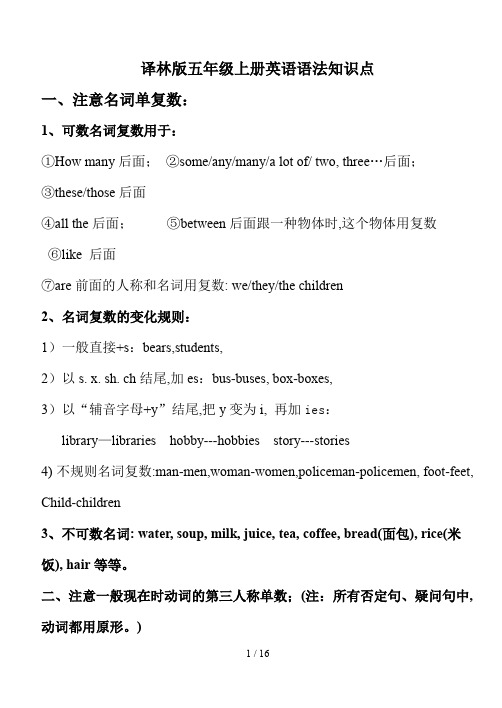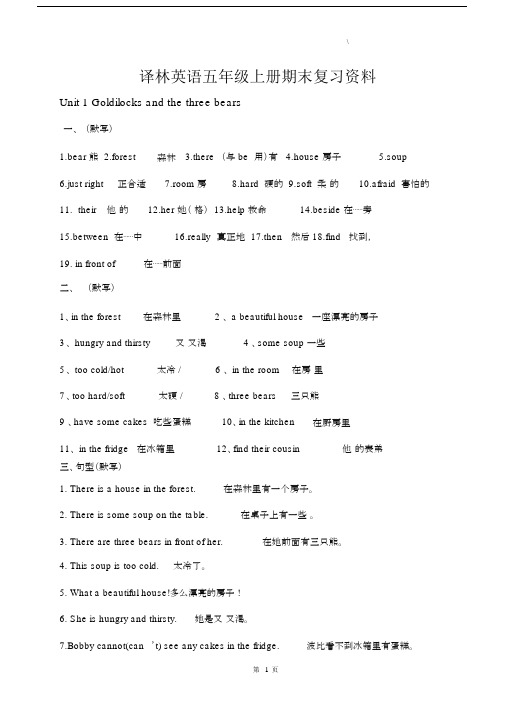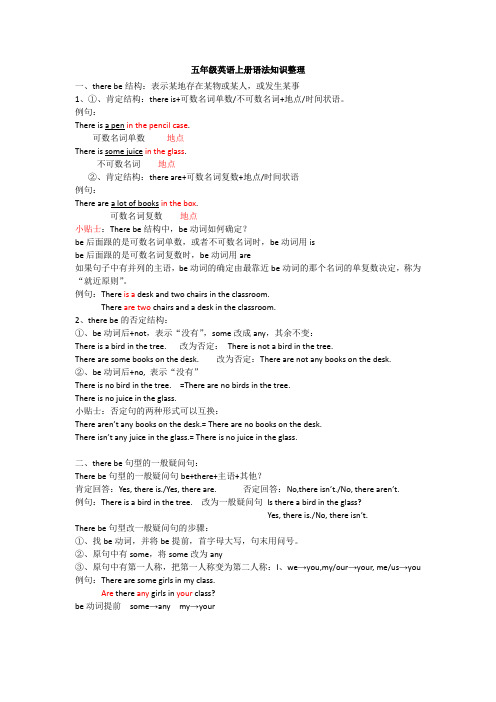最新译林版五年级(上册)英语语法知识点.docx
译林版五年级上册英语语法知识点

译林版五年级上册英语语法知识点一、注意名词单复数:1、可数名词复数用于:①How many后面;②some/any/many/a lot of/ two, three…后面;③these/those后面④all the后面;⑤between后面跟一种物体时,这个物体用复数⑥like 后面⑦are前面的人称和名词用复数: we/they/the children2、名词复数的变化规则:1)一般直接+s:bears,students,2)以s. x. sh. ch结尾,加es:bus-buses, box-boxes,3)以“辅音字母+y”结尾,把y变为i, 再加ies:library—libraries hobby---hobbies story---stories4)不规则名词复数:man-men,woman-women,policeman-policemen, foot-feet, Child-children3、不可数名词: water, soup, milk, juice, tea, coffee, bread(面包), rice(米饭), hair等等。
二、注意一般现在时动词的第三人称单数;(注:所有否定句、疑问句中,动词都用原形。
)1、肯定句中哪些情况下用第三人称单数:(俗称:三单) 1)人称代词he, she, it作主语时;2)单个人名、地名或称呼作主语时;3)单数可数名词或"this / that / the+单数可数名词" 作主语时;4)不可数名词作主语时;5、当数字或字母作主语时,等等。
2、动词第三人称单数变化规则如下:1) 一般情况下,动词后面直接加s. 如:works / plays/ reads2) 以s. x. sh. ch 或o结尾的动词,在后面加es.例:teach-teaches, watch-watches, do-does, go-goes3) 以辅音字母+y结尾的动词, 把y变为i,再加es.例:study- studies fly-flies carry-carries4)不规则动词的第三人称单数:have—has;be—is三、人称代词、名词所有格及序数词1、主格用来作句中的主语,用于动词前面。
(完整)译林版五年级英语上册知识点汇总,推荐文档.docx

\译林英语五年级上册期末复习资料Unit 1 Goldilocks and the three bears一、(默写)1.bear 熊2.forest森林3.there(与 be 用)有4.house 房子5.soup6.just right正合适7.room 房8.hard 硬的9.soft 柔的10.afraid 害怕的11. their他的12.her 她(格) 13.help 救命14.beside 在⋯⋯旁15.between 在⋯⋯中16.really真正地 17.then然后 18.find找到,19. in front of在⋯⋯前面二、(默写)1、in the forest在森林里 2 、 a beautiful house 一座漂亮的房子3、 hungry and thirsty又又渴 4 、some soup 一些5、 too cold/hot太冷 / 6 、 in the room在房里7、too hard/soft太硬 /8 、three bears三只熊9 、have some cakes 吃些蛋糕10、in the kitchen在厨房里11、 in the fridge 在冰箱里12、find their cousin他的表弟三、句型(默写)1.There is a house in the forest.在森林里有一个房子。
2.There is some soup on the table.在桌子上有一些。
3.There are three bears in front of her.在她前面有三只熊。
4.This soup is too cold. 太冷了。
5.What a beautiful house!多么漂亮的房子!6. She is hungry and thirsty.她是又又渴。
7.Bobby cannot(can’t) see any cakes in the fridge.波比看不到冰箱里有蛋糕。
译林版小学英语五年级上册各单元语法知识

精心整理译林版小学英语五年级上册各单元语法知识Unit1-2一.therebe 句型总结1.therebe 表示某处有某物,thereis 后面接单数,或不可数名词,Thereare 后面接可数名词的复数。
2.3.4.5.6.四.1. 2. 五.let 的用法1.是让某人做某事的意思:let 是动词,后面用宾格2.let 后面要用人称代词的宾格Let’s=letus 让我们,letme 让我letit 让它3.Let’sgo 后面要加doing(动词ing). 六.常用的代词Unit3-4一.1.称单数时,用人或物体2.二人称(3.3.Does❖如句子中有和“我有关的”第一人称人称需改成和“你”有关的第二人称人称。
I-you;my-your;we-you;our-your5.肯定回答,Yes,主语+do/does否定回答,No,主语+don’t/doesn’t6.对have,has之后的内容提问用what+do/does+主语+have?二.like的用法1.like+名词的复数,表示喜欢某一类事物。
2.like+动词ing形式,表示喜欢做某事3.否定句:主语+don’t/doesn’tlikedoing…4.一般疑问句:Do/Does+主语+like+doing…?肯定回答:Yes.主语+does/do否定回答;No,主语+doesn’t4.对1.2.skate→take→3.put→shop1.2.以s,x,sh,ch,o结尾加es;go-___________;do-_____________;watch-______________3.以元音字母+y结尾,直接加s;play-_____________;stay-____________4.以辅音字母+y结尾,变y为i,再加es;fly-______________;study-______________;carry-____________。
牛津译林版小学英语五年级上学期语法知识点汇总

1.一般现在时- 动词的原形用于第三人称单数时,加s或es。
- He/She/It + 动词原形 + 其他。
- I/We/You/They + 动词原形 + 其他。
- 动词的否定句,在动词前加do not或doesn’t。
- 动词的一般疑问句,将助动词do/does置于句首。
-使用一般现在时,描述经常发生的事情、客观事实或普遍真理。
例句:- He eats an apple every day.(他每天吃一个苹果。
)- They play football on Saturdays.(他们在周六踢足球。
)- She doesn’t like carrots.(她不喜欢胡萝卜。
)- Do you go to school by bus?(你坐公交车上学吗?)- Does he have a pet dog?(他有一只宠物狗吗?)2.一般过去时-动词的过去式形式。
- 动词的过去式的构成规则:大多数动词加-ed或-d,部分规则发生变化。
例句:- I played basketball yesterday.(我昨天打篮球。
)- She didn’t wat ch TV last night.(昨晚她没看电视。
)- Did you visit your grandparents last weekend?(你上周末去看望你的祖父母了吗?)- Did they have breakfast at home this morning?(他们今天早上在家吃早餐了吗?)3.现在进行时- am/is/are + 动词的ing形式 + 其他。
-表示现在正在进行的动作。
-“现在正在进行”可以和“现在正在发生”混淆,要根据上下文进行判断。
例句:- She is eating lunch now.(她现在正在吃午饭。
)- They are playing basketball in the park.(他们正在公园打篮球。
译林版五年级上册英语语法知识点

五年级上册英语语法知识点一、注意名词单复数:1、可数名词复数用于:①How many后面;②some/any/many/a lot of/ two, three…后面;③these/those后面④all the后面;⑤between后面跟一种物体时,这个物体用复数⑥like 后面⑦are前面的人称和名词用复数: we/they/the children2、名词复数的变化规则:1)一般直接+s:bears,students,2)以s. x. sh. ch结尾,加es:bus-buses, box-boxes,3)以“辅音字母+y”结尾,把y变为i, 再加ies:library—libraries hobby---hobbies story---stories4)不规则名词复数:man-men,woman-women,policeman-policemen,foot-feet, Child-children3、不可数名词: water, soup, milk, juice, tea, coffee, bread(面包), rice(米饭), hair等等。
二、注意一般现在时动词的第三人称单数;(注:所有否定句、疑问句中,动词都用原形。
)1、肯定句中哪些情况下用第三人称单数: (俗称:三单)1)人称代词he, she, it作主语时;2)单个人名、地名或称呼作主语时;3)单数可数名词或 "this / that / the+单数可数名词" 作主语时;4)不可数名词作主语时; 5、当数字或字母作主语时,等等。
2、动词第三人称单数变化规则如下:1) 一般情况下,动词后面直接加s. 如:works / plays/ reads2) 以s. x. sh. ch 或o结尾的动词,在后面加es.例:teach-teaches, watch-watches, do-does, go-goes3) 以辅音字母+y结尾的动词, 把 y变为i, 再加es.例:study- studies fly-flies carry-carries4)不规则动词的第三人称单数:have—has;be—is三、人称代词、名词所有格及序数词例:They are doctors.2、宾格用来作句中的宾语,放在动词或介词的后面。
(译林版)五年级英语上册语法知识整理

五年级英语上册语法知识整理一、there be结构:表示某地存在某物或某人,或发生某事1、①、肯定结构:there is+可数名词单数/不可数名词+地点/时间状语。
例句:There is a pen in the pencil case.可数名词单数地点There is some juice in the glass.不可数名词地点②、肯定结构:there are+可数名词复数+地点/时间状语例句:There are a lot of books in the box.可数名词复数地点小贴士:There be结构中,be动词如何确定?be后面跟的是可数名词单数,或者不可数名词时,be动词用isbe后面跟的是可数名词复数时,be动词用are如果句子中有并列的主语,be动词的确定由最靠近be动词的那个名词的单复数决定,称为“就近原则”。
例句:There is a desk and two chairs in the classroom.There are two chairs and a desk in the classroom.2、there be的否定结构:①、be动词后+not,表示“没有”,some改成any,其余不变:There is a bird in the tree. 改为否定:There is not a bird in the tree.There are some books on the desk. 改为否定:There are not any books on the desk.②、be动词后+no, 表示“没有”There is no bird in the tree. =There are no birds in the tree.There is no juice in the glass.小贴士:否定句的两种形式可以互换:There aren’t any books on the desk.= There are no books on the desk.There isn’t any juice in the glass.= There is no juice in the glass.二、there be句型的一般疑问句:There be句型的一般疑问句be+there+主语+其他?肯定回答:Yes, there is./Yes, there are. 否定回答:No,there isn’t./No, there aren’t.例句:There is a bird in the tree. 改为一般疑问句Is there a bird in the glass?Yes, there is./No, there isn’t.There be句型改一般疑问句的步骤:①、找be动词,并将be提前,首字母大写,句末用问号。
[译林版]五年级英语上册语法知识要点汇总
![[译林版]五年级英语上册语法知识要点汇总](https://img.taocdn.com/s3/m/dbd4a6d4846a561252d380eb6294dd88d1d23d61.png)
[译林版]五年级英语上册语法知识要点汇
总
本文档将对五年级英语上册的语法知识要点进行汇总。
主要包括以下内容:
1. 一般现在时
- 用法:表示经常性的动作、惯、真理、科学事实等。
- 句型结构:主语 + 动词原形
- 示例:I like apples. (我喜欢苹果。
)
2. 一般过去时
- 用法:表示过去发生的动作或存在的状态。
- 句型结构:主语 + 动词过去式
- 示例:She watched a movie last night. (她昨晚看了一部电影。
)
3. 一般将来时
- 用法:表示将来要发生的动作或存在的状态。
- 句型结构:主语 + will + 动词原形
- 示例:I will go to the park tomorrow. (我明天将去公园。
)
4. 现在进行时
- 用法:表示现在正在进行的动作。
- 句型结构:主语 + am/is/are + 动词-ing形式
- 示例:They are playing soccer now. (他们正在踢足球。
)
5. 疑问句
- 用法:用来询问事实、情况、原因等。
- 句型结构:疑问词/助动词 + 主语 + 动词原形
- 示例:What are you doing? (你在做什么?)
以上为五年级英语上册的语法知识要点汇总,希望对你的学习有帮助!。
新版-译林牛津版小学英语五年级英语上册知识点总结

五年级英语上册(译林牛津5A)知识点总结知识点总结Unit 1 Goldilocks and the three bears 一、单词(默写)1熊bear2森林forest3(与be 连用)有there4房子house5汤soup6正合适just right7房间room8硬的hard9柔软的soft10害怕的afraid11他们的their12她(宾格)her13救命help14在??旁边beside15在??中间between16真正地really17然后then18找到,发现find19在??前面in front of二、短语(默写)1在森林里in the forest2一座漂亮的房子 a beautiful house3又饿又渴hungry and thirsty4一些汤_ some soup5太冷too cold6太热too hot7三只熊three bears8太硬too hard9在她前面in front of her10太软too soft11在我前面in front of me12找到他们的表弟find their cousin13在西方国家in Western countries14吃些蛋糕have some cakes15在玻璃杯里in the glass16穿上你们的外套put on your coats17在桌子上on the table18在中国in China19正合适,正好just right20在树上(外来)in the tree21在房间里_ in the room22得了感冒Have a cold23一杯牛奶 a glass of milk24在厨房里_ in the kitchen25在课桌之间_ between the desks26在冰箱里,in the fridge27在盒子里in the box三、句型(默写)1There is a house in the forest.在森林里有一个房子。
- 1、下载文档前请自行甄别文档内容的完整性,平台不提供额外的编辑、内容补充、找答案等附加服务。
- 2、"仅部分预览"的文档,不可在线预览部分如存在完整性等问题,可反馈申请退款(可完整预览的文档不适用该条件!)。
- 3、如文档侵犯您的权益,请联系客服反馈,我们会尽快为您处理(人工客服工作时间:9:00-18:30)。
译林版五年级 ( 上册 ) 英语语法知识点一、注意名词单复数:1、可数名复数用于:①How many后面;②some/any/many/a lot of/ two, three⋯后面;③t hese/those 后面④all the后面;⑤between后面跟一种物体,个物体用复数⑥l ike 后面⑦a re 前面的人称和名用复数 : we/they/the children2、名复数的化:1)一般直接 +s:bears,students,2)以 s. x. sh. ch尾,加es:bus-buses, box-boxes,3)以“ 音字母 +y” 尾 , 把 y i,再加ies:library —libraries hobby---hobbies story---stories4)不名复数 :man-men,woman-women,policeman-policemen, foot-feet, Child-children3、不可数名 : water, soup, milk, juice, tea, coffee, bread( 面包 ), rice( 米 ), hair 等等 .二、注意一般在的第三人称数;( 注:所有否定句、疑句中,都用原形 .)( 俗称:三单 )1、肯定句中哪些情况下用第三人称单数:1)人称代词he, she, it作主语时;2)单个人名、地名或称呼作主语时;3)单数可数名词或"this / that / the+单数可数名词"作主语时;4)不可数名词作主语时;5、当数字或字母作主语时, 等等 .2、动词第三人称单数变化规则如下:1)一般情况下 , 动词后面直接加 s. 如: works / plays/ reads2)以 s. x. sh. ch或o结尾的动词,在后面加es.例:teach-teaches, watch-watches, do-does, go-goes3) 以辅音字母 +y 结尾的动词 ,把y变为i,再加es.例: study- studies fly-flies carry-carries4)不规则动词的第三人称单数:have—has;be—is三、人称代词、名词所有格及序数词单数复数一二三一二三主格I you he she It we you they 宾格me you him her It us you them 物主my your his her Its our your their代词我的你的他的她的它的我们的你们的他们的1、主格用来作句中的主语, 用于动词前面 .例: They are doctors.2、宾格用来作句中的宾语 , 放在动词或介词的后面. 本册书上出现的词组:in front of her show her around push me teach you What’s wrong with him?write him a letterHere’s a Christmas card for you. Let me⋯.chat with them on the Internet give it a cake3、形容词性物主代词 +名词形容词性物主代词 , 之所以叫它们形容词是因为他们必须放在名词前面 . 4、名词所有格作形容词性 , 表示所属关系;在人名或称呼后加’s , 以 s 结尾的 , 直接加’ . 如: mother ’s, parent s’5、序数词 first---second---third---fourth1) 序数词一般要与 the 连用; 2)在某一层楼用介词 on.四、选择和用所给词适当形式填空1、哪些情况加动词原形(注:有to时,to跟后面的动词原形放在同一空格)1) want to +动词原形2)would like to +动词原形 3 )it ’ s time to +动词原形4)情态动词 can+动词原形 5 )助动词(do, does , don’t, doesn’t )+动词原形6)let+ 动词原形7)祈使句中动词用原形( 如Do your homework, please.)8)否定句在句首加Don’t (如Don’t do your homework, please)+动词原形2、哪些情况加动词ing1)like 2)go 3)be good at 4)be 5)后面跟名词,如swimming lesson动词 +ing 变化规则如下 :A、直接加上 ing: draw-drawing play-playing read-readingB 、以不发音的 e 结尾 , 去 e 加上 ing skate-skatingmake-making dance-dancingC、以重读闭音节结尾的单词要双写尾字母, 再加上 ing从单词的末尾开始往前数符合“辅音- 元音 - 辅音”结构的 .(注:词尾是 w和 y 的除外 , 如: drawing, playing等除外);run-running sit-sitting put-puttingchat-chattingget-getting swim-swimming stop-stoppingshop-shopping3.形容加名(形名)如: a beautiful girl4.加副(副)如: swim well5.Some和 any 用法 :“some”一般用于肯定句 , “any”用于否定句和疑句 . 但在一些表示委婉求 , 想得到方肯定回答也用“ some”.( 小技巧:末尾是句号 , 句中是 any, 那句型是否定句 )6.There be 构就近原 , be 的取决于跟在后面的名数量.如: There is a teacher and some students in the classroom.7.器前加 the,球前不加the.如:play the piano, play football8.Who 当作特殊的第三人称数 (Who sing s well? )9.一般在构成: 1) 主 +be(am,is,are)+ 其它 . 2)主 +行 +其它 . 关:always, usually, often, sometimes, on Sundays, every⋯( 注:主第三人称数, 加 s, es或音+y , 把 y i 再加 es;其他时候动词用原形 )10.在行关:look, listen, now( 注:be(is am are) +ing,两者缺一不可)11.and 前后一致 .指当句子中有两个或两个以上的共用同一个主, 一般的保持一致.She often go es fishing and take s photos. Let’s go and have some chicken.12、相同意思不同用法的辨析:1)有; there is/are和have/hasthere is/are表示在某地有某物(或某人);表示存在;there be 就近原;have/has 表示某人有某物;表示所属关系;前面必有主.2)也; too-either-alsotoo用于肯定句和疑句句末;either用于否定句句末;also用于句中. 3)都; both-allboth 用于两者都; all用于三者及以上都.4)好; good-wellgood+名;+well .5) 和; with-andwith 是介 , 意思是“和⋯⋯一起” , 后面跟名或代的格.and 是 , 意思是“和” ,用and接两个数名或代作主,用复数 .五、句型①同句:1. It ’s time for sth=It ’s time to do sth.是⋯了(注:for后面跟名;to 后面跟原形)It ’s time for dinner.=It’s time to have dinner.2.What time is it?=What’s the time?几点呢?3.There is(are) no ⋯(s) ⋯=There isn ’t / aren ’t any ⋯没有⋯4.have no⋯= don ’t have (any)没有⋯They have no legs or arms. =They don’t have any legs or arms.5.has no = doesn ’t have (any)没有⋯6.I like picnics. = I like having picnics.{ 注:like 后面跟名复数或名(+ing)}7.show sth ( 某物 ) to sb(某人 ) = show sb ( 某物 ) sth( 某人 )向⋯展示⋯西8.give sth( 某物 ) to sb(某人 )=give sb (某物 ) sth( 某人 )⋯人⋯西9.What a lovely ant!= How lovely the ant is!多么可的啊10.That is Jan’s umbrella.= That umbrella is Jan’s.那是杰的伞11.What’s wrong with him? = What’s the matter with him?他怎么了?②否定句1、有 be 动词( am, is ,are ),be 后直接加 not (am not/ is not=isn ’t/ are not =aren’t);2、有 can,can 后直接加 not (can not=can’t);3、只有动词 , 在动词原形前加don’t ;三单动词前加doesn’t,动词变回原形 .He does his homework. (改成否定句) He doesn’t do his homework.③一般疑问句 :用Yes或No回答的句子1、有 be 动词 ,be 动词提前;2、有 can 或 would,can 或 would 提前;3、只有动词 , 句首加 Do/ Does,动词用原形;注意: I ’m变 Are you ; some变any; my变your; and变or .④特殊疑问句:有特殊疑问词 +一般疑问句There be 句型提问:1、对数量提问:1)How many +名词复数 + are there +介词短语?(注:对 there be 后面可数名词的数量提问时, 无论主语是单数还是复数, 都用复数形式提问)例: There are 24 classrooms in our school? / There is only one classroom in our school? (对划线部分提问)How many classrooms are there in our school?(注:上面两句提问,都是这句子)2)How much +不可数名词 + is there +介词短语?例: There is somemilk in the glass. (对划线部分提问)How much milk is there in the glass?2、对主语提问there be针对主语提问的特殊疑问句的基本结构是:What’s +介词短语?(注:对there be后面的主语提问时, 无论主语是单数还是复数, 都用What’s 提问)例: There are six books on the desk. / There is a book on the desk. ( 对划线部分提问 )What’s on the desk?(注:上面两句提问,都是这句子)⑤感叹句的结构:感叹句常用how或 what 来引导(1)what 引导的感叹句 , 最终修饰的是名词(2)how引导的感叹句 , 最终修饰的是形容词 / 副词What a lovely ant!= How lovely the ant is!多么可爱的蚂蚁啊!对划线提问 , 疑问词:What 问什么; What colour问颜色;What time问具体时间(如几点钟);when 问范围广的时间; where问在哪里;How old问年龄;how many问数量( 可数名词 );how much 1)问数量(不可数名词) ,2 )问价钱; how about 问怎样;who 问谁(人); whose 问谁的东西(问主人);同音词:B—be—bee,C—see—sea,R—are,T—tea,U—you,Y—why, I-eye,too-two-to,four —for,here —hear,there —their, right—write,sun—son,no—know, pair —pear,it ’s—its, buy—by—bye,hi —high,wear—where,aren ’t —aunt, who’s—whose,近义词 ( 或同义词 ) :Many—lots of —a lot of,desk—table,like —love, tall—high near—beside,too —also,listen—hear,look —see,class —lesson, glass —cup, home — house, beautiful—pretty, usually—often,hi —hello, speak—say—talk, river—lake,would like—want, go home—反义词 ( 或对应词 ) :yes—no,this —that,these —those,here —there,go—— close, big —small, fat—thin, tall—short, long —short, black—white, happy—sad, hot—cold, cool—warm,soft—hard, on—under, in front of —behind,in —out,boy—girl,man—woman, wrong—right,down—up,sit —stand,easy—difficult,take off( 脱下 )—put on( 穿上 )完整形式:I ’m—I am, we’re —we are,you’re —you are,he’s—he is, it’s—it is,there ’s—there is,isn ’t —is not who’s—who is, Let ’s—let us, I’d—I would,can’t —can not,don’t —do not,doesn’t —does not特殊的名词复数:man—men,woman—women,policeman —policemen,child —children, foot—feet,fish —fish, people—people, Chinese-Chinese三单动词变化:特殊的: do---does ; go--goes ; have--has ;teach —teaches ; watch--watches; wash--washes;push--pushes ;brush--brushes; catch--catches;study -- studies;fly--flies;其余的直接加 s.动词变名词 :A. 一般情况下在动词后面直接加er.teach-teacher , work—worker, play—player, sing—singer, find —finderB. 以 e 结尾的动词直接加r.write —writer, drive—driver,—dance—dancerC.符合重读闭音节的动词 , 先双写最后一个字母 , 再加 er.run —runner, begin—beginner, swim—swimmerD. 部分单词在词尾加or.visit—visitor, act—actorE. 本身既是动词又是名词.cook—cook, doctor—doctorCulture板块: U1, U2, U3, U5, U6, U7.1). U1: Coffee is popular in Western countries.Tea is popularin China.咖啡在西方国家受欢迎 .茶在中国受欢迎. 2). U2: In the UK, this is the ground floor.In the US, this is the first floor.在英国 , 这是一楼 .在美国,这是一楼. 3). U3: You can see pandas in China.You can see baldeagles in the US.你在中国可以看到熊猫 .你在美国能看到秃鹰.You can see polar bears in Canada.You can see kangaroos in Australia.你在加拿大能看到北极熊.你在澳大利亚能看到袋鼠.4). U5:In the US, we call a policeman a“cop”. In the UK, we call a firefighter a“fireman”.在美国 , 我们称呼警察为cop.在英国,我们称呼消防队员为 fireman.5). U6: We write Chinese addresses like this.我们这样书写中文地址 .(国名—地名—人名 , 由大到小)We write English addresses like this.我们这样书写英文地址.(人名—地名—国名 , 由小到大)6). U7: Basketball is very popular in the US. Football is very popular in the UK.篮球在美国很受欢迎 .足球在英国很受欢迎.Table tennis is very popular in China.乒乓球在中国很受欢迎 .看国旗写国家名 : (U6)UK Australia ChinaCanada____USSound time:U1:U2:U3:U4: U5:U6:U7:U8: U4 Song time:U8 Song time:。
